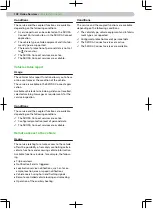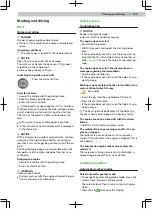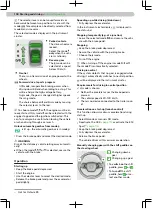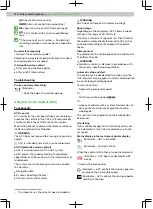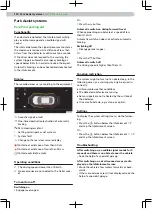
Driver assist systems
Braking and stabilising systems
Overview
Stabilisation control (ESC)
ESC helps to stabilize the vehicle in borderline situa-
tions (e.g. when the vehicle starts to skid). ESC
brakes the individual wheels to maintain the direc-
tion of travel.
flashes - ESC is engaged
ESC Sport
ESC Sport allows for a sportier driving style.
lit up - ESC Sport is activated
Traction control (TCS)
ASR helps to stabilize the vehicle when accelerating
or driving on low-grip roads. ASR reduces the drive
power transmitted to the wheels when the wheels
spin.
flashes - ASR is engaged
Antilock braking system (ABS)
ABS helps maintain control of the vehicle during
emergency braking. An ABS intervention is noticea-
ble by pulsating movements of the brake pedal.
Motor Slip Regulation (MSR)
MSR helps to maintain control of the vehicle in the
event of a sudden reduction in speed, e.g. on icy
roads. If the drive wheels lock, MSR increases the
engine speed. This reduces the braking effect of the
engine and the wheels can rotate freely again.
Electronic Differential Lock (EDL)
EDL helps to stabilize the vehicle when driving on
road surfaces with different grip under the individual
wheels. EDL brakes a spinning wheel and transmits
power to a different drive wheel.
Electronic Differential Lock (XDL+)
XDL + helps to stabilize the vehicle during fast cor-
nering by braking the inside wheel of the driven axle.
Active steering assistance (DSR)
In difficult situations, the DSR provides the driver
with a steering recommendation in order to stabilise
the vehicle.
Hill Hold Control
Hill Hold Control helps when starting off on uphill
gradients by braking the vehicle for about 2 seconds
after the brake pedal is released.
Operating conditions
✓
The gradient is at least 5%.
✓
The driver's door is closed.
Multi-Collision Brake (MCB)
MCB helps to decelerate and stabilize the vehicle af-
ter a collision with an obstacle. This reduces the risk
of further collisions.
Operating conditions
✓
There has been a frontal, side and rear collision of
a certain severity.
✓
The impact speed was greater than 10 km/h.
✓
The brakes, ESC and other required systems re-
mained functional after the impact.
✓
The accelerator pedal is not pressed.
Trailer Stability Assist (TSA)
TSA helps to stabilize the trailer. As the trailer begins
to lurch, TSA stabilizes the trailer by slowing down
the individual vehicle wheels.
Operating conditions
✓
The hitch was supplied from the factory or pur-
chased from ŠKODA Genuine Accessories.
✓
The trailer is connected to the trailer socket.
✓
ASR activated.
✓
The driving speed is higher than 60 km/h.
Electromechanical brake booster (eBKV)
eBKV (electronic brake force distribution) facilitates
operation of the brake pedal. At the same time,
charging of the high-voltage battery is made possi-
ble through regenerative braking.
After switching off the ignition, the eBKV (electronic
brake force distribution) function is either restricted
or not available.
If the vehicle is decelerated using an assistance
system, pulsating movements of the brake pedal can
occur.
Regenerative braking
Regenerative braking produces energy that is stored
in the high-voltage battery. The force of the braking
effect depends on the selected driving mode, as well
as the state of charge of the high-voltage battery.
During regenerative braking, pulsating movements
of the brake pedal and fluctuating decelerations of
the vehicle can occur.
Settings
Deactivating/activating ASR
›
Press the
button under the Infotainment.
In the displayed menu in the Infotainment, the func-
tion can be deactivated or activated.
When deactivated, lights up in the instrument
cluster.
goes out on renewed activation.
112 Driver assist systems ›
Braking and stabilising systems





